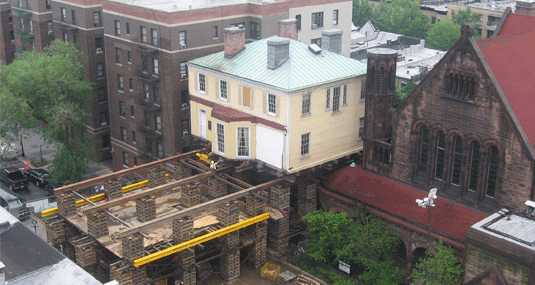In the Media
- News,
Hamilton Home Heads to a Greener Address

On Saturday, the two-story, 298-ton wood-frame house will be rolled conspicuously — and slowly — from its cramped site on Convent Avenue to an appropriately verdant new location a block away in St. Nicholas Park, facing West 141st Street.
That is as close as it can get these days to the rural setting for which it was originally designed.
Once new foundations are completed, a yearlong, $8.4 million restoration and reconstruction will undo decades of unsympathetic alterations to the house, known formally as the Hamilton Grange National Memorial in New York.
Stephen Spaulding, chief of the architectural preservation division in the National Park Service’s Northeast region, said the 500-foot move on Saturday should take three to six hours.
But in a sense, the journey has taken almost half a century. In 1962, President John F. Kennedy authorized the Interior Department to assume ownership of the house on the condition that it be moved to a suitable location.
As redevelopment sagas go, the story of the Grange ranks among the most protracted. For want of money and almost any concerted political will to get the deed done, at least until recent years, the Grange languished in near-obscurity as other historical landmarks gained a higher profile.
Visitors have found the Grange jammed between a six-story apartment house and St. Luke’s Episcopal Church, its formal front facade abutting the church and all but invisible. Nor is this even its original location. Until 1889, when it was moved for the first time, the house was on 143rd Street, west of Convent Avenue.
Lost in the intervening years was any public sense that the founding father on the $10 bill, the nation’s first treasury secretary, had lived in Harlem; that a creator of the federal government passed his last two years in a refined country estate designed by John McComb Jr., an architect of City Hall, from which he departed in 1804 for the duel with Aaron Burr that cost him his life.
Now, in the house he left behind, Hamilton is again coming to life. To their joy, National Park Service officials have discovered that the front stairway, though much modified over time, is essentially the one built for Hamilton, complete with original risers, treads, balusters, ornamental scrollwork and support structure. It will be rebuilt in its original form.
“Alexander Hamilton ran up those very treads!” said Steve Laise, chief of cultural resources of Manhattan sites for the National Park Service, which owns and runs the Grange. “It just puts you in such close proximity with the past. For those of us who really wish we were living back then anyway, it’s probably more of a stimulus to our imagination than we really ought to have.”
Lovely exterior details are also evident for the first time in more than a century, including a triple-hung sash window. Smaller windows on either side have an alternating star-and-circle tracery. “That kind of pattern is well rooted in 18th-century Anglo-American design practice,” said Seth Joseph Weine, a fellow of the Institute of Classical Architecture and Classical America.
Last week, the Grange was raised up and over a loggia, or side porch, at St. Luke’s and now sits on steel beams atop nine dollies in the middle of Convent Avenue. On Saturday, it will be rolled down the avenue; turned east onto 141st Street; rolled down a hillside with a 6 percent grade, past Steinman Hall of City College; turned south at Hamilton Terrace; then rolled into the park.
Windows, especially those at the corners, will be among the most vulnerable areas. To reduce any chance that the structure will shift out of shape, it is being bound tightly with wire rope and tied diagonally to the beams on which it is now supported. The chimneys are also to be braced.
Twice during the move, the house will be inspected. Windows will be tested to ensure that they are operable, meaning that no undue pressure is being exerted against the frames. Existing plaster cracks, already documented, will be checked to make certain they are not widening. If problems do arise, Mr. Spaulding said the house can be releveled by adjusting the blocking between the steel beams and the frame of the structure.
For now, he does not anticipate any need to halt the move outright.
As for that 6 percent slope on 141st Street, Mr. Spaulding said the contractor “is very confident that the grade is not going to be a problem.”
“He’s moved houses down grades like that before,” he added. The move itself is being done by Wolfe House and Building Movers of Bernville, Pa. The general contractor is Integrated Construction Enterprises of Belleville, N.J.
Each of the nine dollies has its own propulsion and braking system, Mr. Spaulding said, powered electrically and hydraulically. “If there’s any failure of the systems,” he said, “the brakes lock up.” There are four brakes on each dolly, for a total of 36 brakes.
Mr. Spaulding and his colleagues will breathe easier on Saturday night, but given the reconstruction and restoration ahead, they will not have much chance to relax. “Our goal for reopening the house would be the fall of next year,” he said. “There’s a lot more work to do.”
Hamilton Home Heads to a Greener Address
To read the original article please click here.
